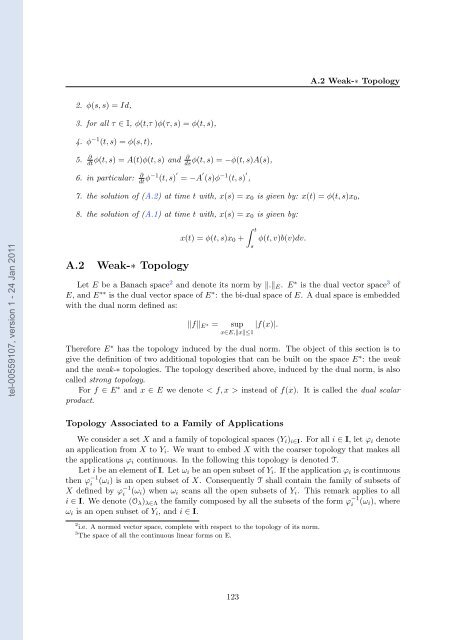Adaptative high-gain extended Kalman filter and applications
Adaptative high-gain extended Kalman filter and applications
Adaptative high-gain extended Kalman filter and applications
Create successful ePaper yourself
Turn your PDF publications into a flip-book with our unique Google optimized e-Paper software.
tel-00559107, version 1 - 24 Jan 2011<br />
2. φ(s, s) =Id,<br />
3. for all τ ∈ I, φ(t,τ )φ(τ,s)=φ(t, s),<br />
4. φ −1 (t, s) =φ(s, t),<br />
5. ∂<br />
∂<br />
dtφ(t, s) =A(t)φ(t, s) <strong>and</strong> dsφ(t, s) =−φ(t, s)A(s),<br />
6. in particular: ∂<br />
dt φ−1 (t, s) ′<br />
= −A ′<br />
(s)φ −1 (t, s) ′<br />
,<br />
A.2 Weak-∗ Topology<br />
7. the solution of (A.2) at time t with, x(s) =x0 is given by: x(t) =φ(t, s)x0,<br />
8. the solution of (A.1) at time t with, x(s) =x0 is given by:<br />
A.2 Weak-∗ Topology<br />
� t<br />
x(t) =φ(t, s)x0 + φ(t, v)b(v)dv.<br />
Let E be a Banach space 2 <strong>and</strong> denote its norm by �.�E. E ∗ is the dual vector space 3 of<br />
E, <strong>and</strong> E ∗∗ is the dual vector space of E ∗ : the bi-dual space of E. A dual space is embedded<br />
with the dual norm defined as:<br />
�f�E ∗ = sup<br />
x∈E,�x�≤1<br />
|f(x)|.<br />
Therefore E ∗ has the topology induced by the dual norm. The object of this section is to<br />
give the definition of two additional topologies that can be built on the space E ∗ : the weak<br />
<strong>and</strong> the weak-∗ topologies. The topology described above, induced by the dual norm, is also<br />
called strong topology.<br />
For f ∈ E ∗ <strong>and</strong> x ∈ E we denote < f, x > instead of f(x). It is called the dual scalar<br />
product.<br />
Topology Associated to a Family of Applications<br />
We consider a set X <strong>and</strong> a family of topological spaces (Yi)i∈I. For all i ∈ I, let ϕi denote<br />
an application from X to Yi. We want to embed X with the coarser topology that makes all<br />
the <strong>applications</strong> ϕi continuous. In the following this topology is denoted T.<br />
Let i be an element of I. Let ωi be an open subset of Yi. If the application ϕi is continuous<br />
then ϕ −1<br />
i (ωi) is an open subset of X. Consequently T shall contain the family of subsets of<br />
X defined by ϕ −1<br />
i (ωi) when ωi scans all the open subsets of Yi. This remark applies to all<br />
i ∈ I. We denote (Oλ)λ∈Λ the family composed by all the subsets of the form ϕ −1<br />
i (ωi), where<br />
ωi is an open subset of Yi, <strong>and</strong> i ∈ I.<br />
2 i.e. A normed vector space, complete with respect to the topology of its norm.<br />
3 The space of all the continuous linear forms on E.<br />
123<br />
s

















